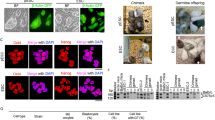Abstract
The effects of total removal of paternal accessory sex glands (TX) on preimplantation embryonic development was studied in the golden hamster model. Cell numbers of the two groups of embryos did not differ up to 60 h p.c., but at 66 and 70 h p.c., each TX embryo has 2 and 3 cells less respectively (P<0.05, TX vs SH). At 70 h p.c., 46.6±4.4 of the TX embryos blastomeres were labelled with the terminal deoxynucleotide transferase – mediated dUTP-nickend-labelling technique, compared with 31.5±2.1 in the SH group (P<0.01, TX vs SH). No difference was found in the SDS-PAGE profiles of two-cell embryos from the two groups. An extra band corresponding to 136.5 kDa was consistently found in the four-cell TX embryos. The nascent proteins profiles of four-cell embryos from the two groups were similar. As the embryos progressed from two to four cells, the protein content decreased by 16% in the SH embryos (P<0.05) and 7% in the TX embryos. These observations suggest that total ablation of paternal accessory sex glands could result in developmental aberrations from the two-cell to morula stages and a higher incidence of apoptosis at 70 h p.c.
Similar content being viewed by others
Author information
Authors and Affiliations
Additional information
Accepted: 28 March 2001
Rights and permissions
About this article
Cite this article
Chan, O., Chow, P. & O, W. Total ablation of paternal accessory sex glands curtails developmental potential in preimplantation embryos in the golden hamster. Anat Embryol 204, 117–122 (2001). https://doi.org/10.1007/s004290100186
Issue Date:
DOI: https://doi.org/10.1007/s004290100186




